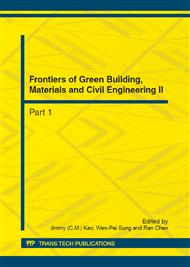[1]
Miroslaw Zukowski. Experimental study of short term thermal energy storage unit based on enclosed phase change material in polyethylene film bag[J]. Energy Conversion and Management 2007; 48: 166-173.
DOI: 10.1016/j.enconman.2006.04.020
Google Scholar
[2]
A. Pasupathy, L. Athanasius, R. Velraj, R.V. Seeniraj. Experimental investigation and numerical simulation analysis on the thermal performance of a building roof incorporating phase change material(PCM) for thermal management[J]. Applied Thermal Engineering 2008; 28: 556-565.
DOI: 10.1016/j.applthermaleng.2007.04.016
Google Scholar
[3]
Weilong Wang, Xiaoxi Yang, Yutang Fang, Jing Ding. Preparation and performance of form-stable polyethylene glycol/silicon dioxide composites as solid-liquid phase change materials[J]. Applied Energy 2009; 86: 170-174.
DOI: 10.1016/j.apenergy.2007.12.003
Google Scholar
[4]
Yutang Fang, Huiying Kang, Weilong Wang, Hong Liu, Xuenong Gao. Study on polyethylene glycol/epoxy resin composite as a form-stable phase change material[J]. Energy Conversion and Management 2010; 51: 2757-2761.
DOI: 10.1016/j.enconman.2010.06.012
Google Scholar
[5]
Lijiu Wang, Duo Meng. Fatty acid eutectic polymethyl methacrylate composite as form-stable phase change material for thermal energy storage[J]. Applied Energy 2010; 87: 2660-2665.
DOI: 10.1016/j.apenergy.2010.01.010
Google Scholar
[6]
Sari A. Thermal reliability test of some fatty acids as PCMs used for solar thermal latent heat storage applications[J]. Energy Convers. Manage 2003; 44: 2277-87.
DOI: 10.1016/s0196-8904(02)00251-0
Google Scholar
[7]
Min Li, Hongtao Kao, Zhishen Wu, Jinmiao Tan. Study on preparation and thermal property of binary fatty acid and the binary fatty acids/diatomite composite phase change materials[J]. Applied Energy 2011; 88: 1606-1612.
DOI: 10.1016/j.apenergy.2010.11.001
Google Scholar
[8]
Feldman D, Banu D. Obtaining an energy storing building material by direct incorporation of an organic phase change material in gypsum wallboard[J]. Solar Energy Materials1991; 22(2-3): 231-242.
DOI: 10.1016/0165-1633(91)90021-c
Google Scholar
[9]
D. Feldman, D. Banu, D.W. Hawes. Develop and application of organic phase change mixtures in thermal storage gypsum wallboard[J]. Solar Energy Materials and Solar Cells1995; 36: 147-157.
DOI: 10.1016/0927-0248(94)00168-r
Google Scholar
[10]
Hawlader M N, Uddin M S, Khin M M. Microencapsulated phase change materials thermal-energy storage[J]. Applied Energy2003; 74: 195-202.
DOI: 10.1016/s0306-2619(02)00146-0
Google Scholar
[11]
Zhang Dong, Zhou Jian-min, Wu Ke-ru, Li Zong-jin. Study on fabrication method and energy-storing behavior of phase changing energy storing concrete[J]. Journal of Building Materials 2003; 6(4): 374-380.
Google Scholar
[12]
Esam M. Alawadhi. Thermal analysis of a building brick containing phase change material[J]. Energy and buildings 2008; 40: 351-357.
DOI: 10.1016/j.enbuild.2007.03.001
Google Scholar
[13]
Chao Chen, Haifeng Guo, Yuning Liu, Hailin Yue, Chendong Wang. A new kind of phase change material(PCM) for energy-storing wallboard[J]. Energy and Buildings2008; 40: 882-890.
DOI: 10.1016/j.enbuild.2007.07.002
Google Scholar
[14]
M.J. Huang, P.C. Eames, N.J. Hewitt. The application of a validated numerical model to predict the energy conservation potential of using phase change materials in the fabric of a building[J]. Solar Energy Materials & Solar Cells 2006; 90: 1951-(1960).
DOI: 10.1016/j.solmat.2006.02.002
Google Scholar
[15]
D A Neeper. Thermal dynamics of wallboard with latent heat storage[J]. Solar Energy2000; 68: 393-403.
DOI: 10.1016/s0038-092x(00)00012-8
Google Scholar
[16]
Jin Longfei, Xiao Fengping. Phase diagram of the ternary system lauric acid-capric acid-naphthalene[J]. Thermochimica Acta 2004; 424: 1-5.
DOI: 10.1016/j.tca.2004.04.009
Google Scholar
[17]
Lv Shilei, Zhu Neng, Feng Guohui. Eutectic mixtures of capric acid and lauric acid applied in building wallboards for heat energy storage[J]. Energy and Buildings2006; 38: 708-711.
DOI: 10.1016/j.enbuild.2005.10.006
Google Scholar


